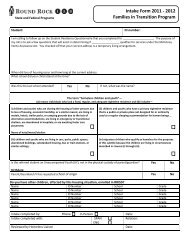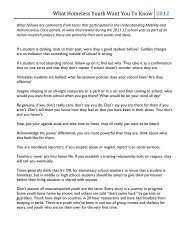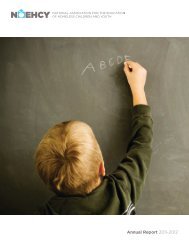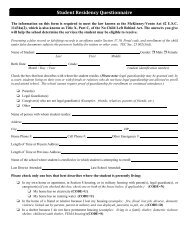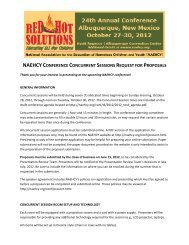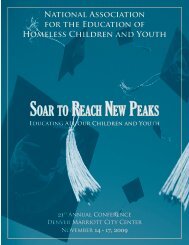The McKinney-Vento Act and Children and Youth ... - State of Michigan
The McKinney-Vento Act and Children and Youth ... - State of Michigan
The McKinney-Vento Act and Children and Youth ... - State of Michigan
Create successful ePaper yourself
Turn your PDF publications into a flip-book with our unique Google optimized e-Paper software.
WHO IS RESPONSIBLE FOR ENROLLING THE YOUTH IN SCHOOL?<br />
Interviews for this report indicated that when the adults in a student’s life do<br />
not know who is supposed to enroll the child in school, at least two negative<br />
consequences can result:<br />
• No one enrolls the child, <strong>and</strong> the child misses school.<br />
• Someone without authority enrolls the child in an inappropriate<br />
school.<br />
Child welfare agencies should assign responsibility for school enrollment<br />
clearly <strong>and</strong> ensure that schools know where that responsibility lies.<br />
WHO DECIDES BETWEEN THE SCHOOL OF ORIGIN AND THE LOCAL SCHOOL?<br />
<strong>Children</strong> <strong>and</strong> youth awaiting foster care placement have the right to remain<br />
in their school <strong>of</strong> origin or enroll in the local school, depending upon their<br />
best interests. <strong>The</strong> <strong>McKinney</strong>-<strong>Vento</strong> <strong>Act</strong> gives parents <strong>and</strong> youth the right<br />
to participate in that best-interest decision <strong>and</strong> appeal decisions with which<br />
they do not agree. However, in the case <strong>of</strong> youth in out-<strong>of</strong>-home care, it may<br />
be unclear who is considered the “parent” for such purposes. This must be<br />
clarified to help avoid confusion, disputes, <strong>and</strong> poor education decisions.<br />
Education <strong>and</strong> child welfare agencies, as well as individual schools <strong>and</strong><br />
caseworkers, must be informed <strong>of</strong> who is empowered to make such decisions.<br />
Models for choosing between the local school <strong>and</strong> the school <strong>of</strong> origin that<br />
are in use in the jurisdictions interviewed include the following:<br />
JURISDICTION<br />
MODEL<br />
FOR MORE<br />
INFORMATION<br />
<strong>The</strong> Massachusetts<br />
Department <strong>of</strong> Elementary<br />
<strong>and</strong> Secondary Education<br />
Homeless Education<br />
Advisory 2004−9 states that<br />
children <strong>and</strong> youth in state<br />
care or custody “...may be<br />
enrolled by the social worker<br />
or the parent/guardian.”<br />
Delaware’s Draft MOU<br />
establishes that the<br />
“Department <strong>of</strong> Services<br />
for <strong>Children</strong>, <strong>Youth</strong> <strong>and</strong><br />
<strong>The</strong>ir Families shall...enroll<br />
a child who is in foster<br />
care in school immediately<br />
(24-48 hours), once DSCYF<br />
staff has faxed registration<br />
materials (including IEP,<br />
if applicable). <strong>The</strong> child<br />
may be brought to the<br />
school by the foster parent<br />
to complete additional<br />
paperwork needed by the<br />
school (e.g., emergency<br />
card).”<br />
Arizona<br />
Caseworker leads the bestinterest<br />
determination with<br />
the homeless liaison, including<br />
input from the out-<strong>of</strong>-home<br />
caregiver, the school district, <strong>and</strong><br />
the parent.<br />
<strong>Children</strong>’s<br />
Services Manual<br />
<strong>of</strong> the Arizona<br />
Division <strong>of</strong><br />
<strong>Children</strong>, <strong>Youth</strong><br />
<strong>and</strong> Families<br />
(see, Legal Center<br />
for Foster Care &<br />
Education, www.<br />
abanet.org/child/<br />
education)<br />
Strategies for Improving Educational Outcomes through School Stability 41




